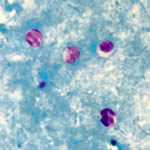Diagnosis & Detection

Cryptosporidium oocysts in a modified acid-fast stain. (CDC Photo; DPDx)
Diagnosis of cryptosporidiosis is made by examination of stool samples. Because detection of Cryptosporidium can be difficult, patients may be asked to submit several stool samples over several days. Most often, stool specimens are examined microscopically using different techniques (e.g., acid-fast staining, direct fluorescent antibody [DFA] , and/or enzyme immunoassays for detection of Cryptosporidium sp. antigens).
Molecular methods (e.g., polymerase chain reaction – PCR) are increasingly used in reference diagnostic labs, since they can be used to identify Cryptosporidium at the species level. Tests for Cryptosporidium are not routinely done in most laboratories; therefore, healthcare providers should specifically request testing for this parasite.
Related Links
For more information about laboratory diagnosis of cryptosporidiosis, see the DPDx Web site:
- Page last reviewed: April 1, 2015
- Page last updated: November 4, 2016
- Content source:


 ShareCompartir
ShareCompartir